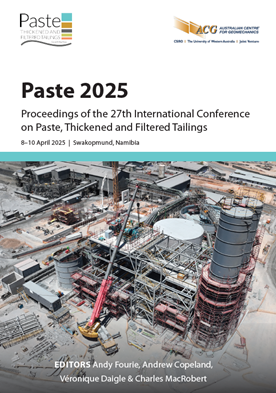A structured approach to co-disposal program development: standardising methodologies for efficient and cost-effective mine waste management

|
Authors: Rizzuto, M; Wickland, B; Castendyk, D |
DOI https://doi.org/10.36487/ACG_repo/2555_36
Cite As:
Rizzuto, M, Wickland, B & Castendyk, D 2025, 'A structured approach to co-disposal program development: standardising methodologies for efficient and cost-effective mine waste management', in AB Fourie, A Copeland, V Daigle & C MacRobert (eds), Paste 2025: Proceedings of the 27th International Conference on Paste, Thickened and Filtered Tailings, Australian Centre for Geomechanics, Perth, pp. 513-526, https://doi.org/10.36487/ACG_repo/2555_36
Abstract:
Co-disposal involves the storage of tailings and mine waste rock together in a single facility. Mixing waste rock and tailings, called commingling, is a form of co-disposal that offers potential benefits over conventional mine waste storage methods, including a more efficient use of space at a mine site, increased geotechnical stability relative to tailings alone, improved seepage water quality relative to waste rock alone, water recovery, and others. In recent years, co-disposal technologies have received increased interest within the mining industry, with several mine owners committing to studies to evaluate co-disposal as a mine waste disposal technology for specific sites and for general application. However, a standardised methodology for evaluating and developing co-disposal – from concept through operational implementation – is currently lacking. Eagerness to ‘try it out’ – to implement field trials without setting objectives based on identified use cases – can lead to unmeasurable or inconclusive outcomes. This paper proposes a comprehensive methodology for developing and executing a tailings and waste rock co-disposal technology development program, including sequencing of project stages and gates within the project cycle. The focus is technical, with a multidisciplinary framework including process/dewatering, geotechnical and geochemical disciplines for testing campaigns at different scales correlated to project phase, illustrating the interactions between the testing programs. The proposed methodology provides a structured approach to co-disposal program development, ensuring that mine owners can make informed decisions to achieve efficient, cost-effective outcomes.
Keywords: co-disposal, commingling, tailings, waste rock, mine waste
References:
Bareither, CA, Scalia, J & Aparicio, M 2022, ‘Case studies in commingling part 2: water balance observation from field-scale commingled and waste rock test piles in a sub-tropical highland climate’, in M Edraki, D Jones & KR Jain (eds.), Proceedings of the 12th International Conference on Acid Rock Drainage, Sustainable Minerals Institute, The University of Queensland, Brisbane, pp. 388–397,
Castendyk, D, Aparicio, M, Verburg, R & Thompson, JA 2022, ‘Potential benefits of comingling waste rock and tailings as indicated from a multi-year field trial’, in M Edraki, D Jones & KR Jain (eds.), Proceedings of the 12th International Conference on Acid Rock Drainage, Sustainable Minerals Institute, The University of Queensland, Brisbane, pp. 398–410,
International Council on Mining and Metals, United Nations Environment Programme, & Principles for Responsible Investment 2020, Global Industry Standard on Tailings Management,
Leon, C & Espinoza, C 2024, ‘Antamina's codisposal project - a holistic Vision’, presented at 9no Congreso de Relaves Peru (9th Peru Tailings Congress), DEEV,.
Machin, D 2024, ‘Antamina's codisposal project - testing program requirements’, presented at 9no Congreso de Relaves Peru (9th Peru Tailings Congress), DEEV, Lima.
Wickland, B & Longo, S 2017, ‘Mine waste case examples of stacked tailings and co-disposal’, Proceedings of the 21st International Conference on Tailings and Mine Waste, The University of Alberta, Edmonton.
Wickland, B, Wilson, GW & Johnson, G 2003, ‘A meso-scale column test for co-mixed tailings and waste rock’, Application of Sustainability of Technologies: Proceedings of the 6th International Conference on Acid Rock Drainage, Australian Institute of Mining and Metallurgy, Melbourne, pp. 1171–1173.
Wickland, B, Wilson, GW, Wijewickreme, D, & Klein, B 2006, ‘Design and evaluation of mixtures of mine waste rock and tailings’, Canadian Geotechnical Journal, vol. 43, no. 9, pp. 928–945,
Wilson, GW, Wickland, B, Miskolczi, I, Andrina, J & Salzsauler, K 2022, ‘Commingling waste rock and tailings to produce geochemical and physical stability in mine waste deposits’, in M Edraki, D Jones & KR Jain (eds.), Proceedings of the 12th International Conference on Acid Rock Drainage, Sustainable Minerals Institute, The University of Queensland, Brisbane, pp. 38–54,
Wisdom, T, Jacobs, M & Chaponnel, J 2018, ‘GeoWasteTM – continuous comingled tailings for largescale mines’, in RJ Jewell & AB Fourie (eds), Paste 2018: Proceedings of the 21st International Seminar on Paste and Thickened Tailings, Australian Centre for Geomechanics, Perth, pp. 465–472,
© Copyright 2025, Australian Centre for Geomechanics (ACG), The University of Western Australia. All rights reserved.
View copyright/legal information
Please direct any queries or error reports to repository-acg@uwa.edu.au
View copyright/legal information
Please direct any queries or error reports to repository-acg@uwa.edu.au
